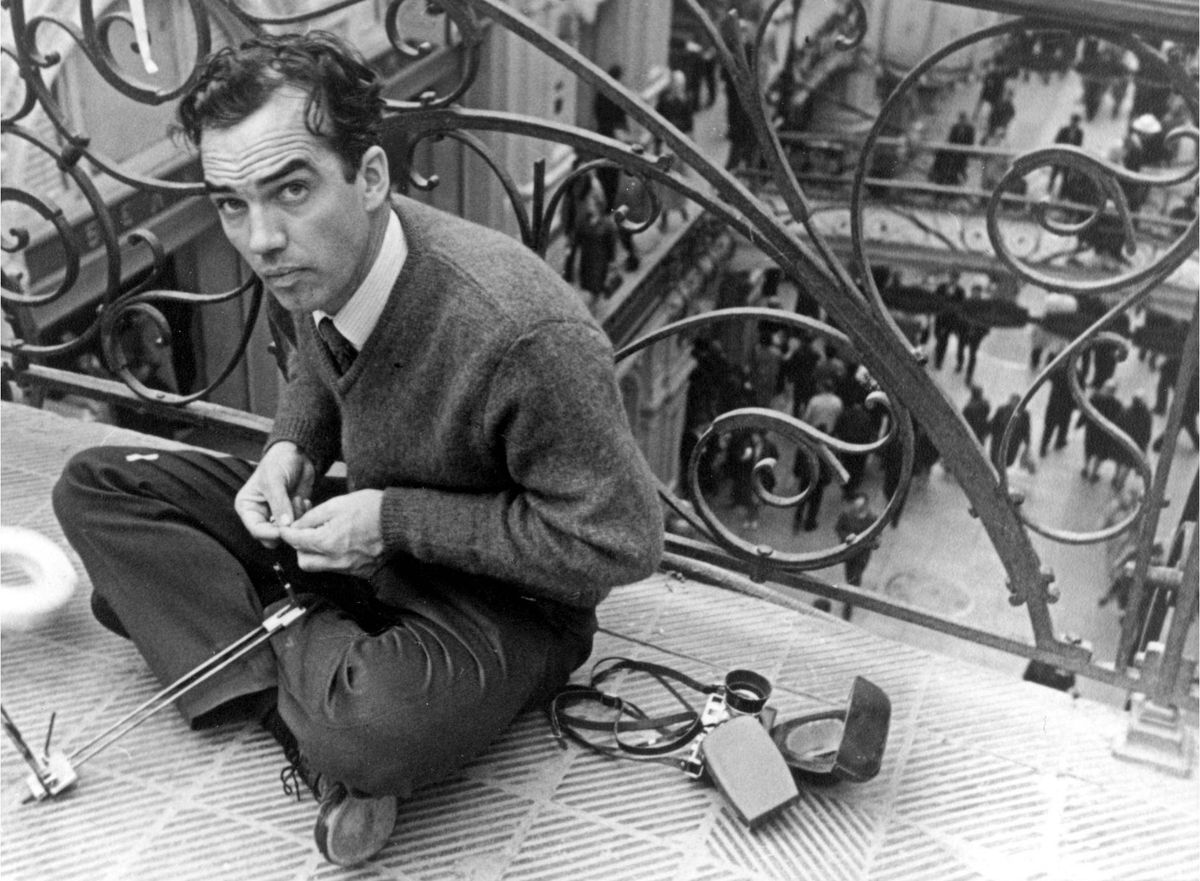In POV #97, Sergeo Kirby asked a series of needed questions about the landscape of interactive documentary. (Read Kirby’s article here.) Unfortunately, it felt like many of the answers he provided were reached before he started writing the article. Sergeo is a friend whose innovations have contributed some great things to Canadian doc culture, but that article can’t skate by without a rebuttal.
His first question is one that the Canadian documentary community certainly needs to ask: “Does the interactive digital documentary (directly or indirectly) negatively affect the traditional narrative documentary?” Too bad Sergeo dodges his own question by diving into inside baseball, Canadian policy-style. The CMF (Canadian Media Fund) requirement that all producers who access their fund create a digital component is a decision the documentary community should interrogate and assess. But should that decision, for good or bad, be placed at the feet of an entire genre of non-fiction? Is it not more the result of policy decisions set in motion by the first heritage minister of Stephen Harper’s first mandate as Prime Minister?
Interactive documentary is such a nascent form that it can be all things to all people. In his article, Kirby conflates marketing campaigns for documentary film with creative non-fiction made for digital media. He then interviews a series of doc makers who are admittedly blasé about the creative potential of interactive.
These practitioners didn’t bring us any closer to answering Kirby’s question about the positive or negative effects of interactive docs, but they don’t seem to have been dissuaded from their preferred mode of documentary making either. I can see where doc filmmakers would have a beef with the CMF if the issue was about an ever-shrinking public funding pie being cut too many ways, but Kirby didn’t make this analysis. Instead he chose to throw shade on the genre and suggested that the “buzz” of interactive docs detracts from the one true documentary form. His, we are left to assume. My experience as an interactive documentary producer is that our work is still treated as a dalliance, a stepchild to the “serious” (aka character-driven verité) documentaries within our community, so I found Kirby’s analysis problematic.
Another question that the doc community really needs to ask is, “Who is our audience and what do they want?” But it is unfortunately framed in “The Interactive Paradox” as “Why are they hiding the numbers?”
Kirby says, “There is a reason [interactive doc] producers will not give you this information, and that’s because the numbers suck.” I’d rephrase that as, “We’re hesitant to discuss these numbers with people who have an agenda and don’t know how to look at Google Analytics.” The problem with metrics is that they can prove whatever you want.
Sergeo Kirby is indeed correct that interactive documentaries have small audiences. The idea that this is based on their form, however, ignores the tectonic shifts that have happened in web publishing in even the last 12 months. Whereas the web once promised to democratize access to audiences and render gatekeepers obsolete, we now find ourselves at the mercy of Facebook’s cynical algorithms and the shift from desktop web viewing to mobile apps.
Yes indeed, it’s just as hard to get your doc seen on the web as it is to get a distribution deal for your essay film. It’s supposed to be hard, and it’s the same as it ever was, though I’m not sure that the average Canadian traditional long-form doc (which Kirby feels that interactives are threatening) would do better in a metrics shoot-out. What do the numbers look like for Canadians who attend film festivals or watch docs on the ever-shrinking digital channels that buy them? We all took the vow of poverty; it’s an oath for all documentarians.
Interactive producers need to develop audiences just the same as doc film producers do. And, sadly, just because producers and marketers build it, audiences may not come. This dynamic should be foreign to no one reading this, and we should be doing all we can to build platforms that can compete with Silicon Valley. The NFB should be encouraged to innovate as strongly in building pathways to audiences as they are with pioneering new forms, but we shouldn’t clutch our pearls if they deliver content to those audiences that deviates from the character-driven documentary.
“Astonishingly, the most successful web docs keep the viewer on-line for 10 minutes.” —Sergeo Kirby, “The Interactive Paradox”
If you’re making content for the web or mobile, you need to meet your audience where they’re at. Oftentimes that is at work, on the go, or while multi-tasking. That’s how we use the web (unless, of course, it’s time for Netflix and Chill). So the successful interactive producer should tailor her content for those modes. It’s content that you might follow from social media, that is shareable, that perfectly explains a concept, that immediately triggers an emotion. The interactive producer is up against listicles, Upworthy memes, your latest Zappos purchase, the shitty WiFi at the cafe and the drunk guy onthe bus. Imagine watching WalTown or H2Oil in this environment. Would you consider the likely bounce rate of such an experiment “a complete and utter failure”? Kirby’s apples to-oranges comparison between the audience in front of their computer and those in the theatre doesn’t make sense.
Let’s look at the interactive documentary we just made with media partners Arte, Upian, the NFB and BR (Bayerischer Rundfunk), Do Not Track. We followed a serial format, releasing a new short-form episode every two weeks. An episode consisted of a personalised short film (none were longer than ten minutes), a lead article written in collaboration with a media partner, a series of further links and an email to registered users. During the “live” moment of the project (mid-April to mid-June), the average session duration was six minutes. Our bounce rate was 11 per cent, a very low number for a typical web site. So, only 11 per cent of people left immediately without interacting with the programme in any way (the dreaded bounce). That means that the AVERAGE session time, including those pesky bouncers, was six minutes long, for a series of videos that were…about six minutes long. The context of those six minutes is pretty important. We wouldn’t deem a powerful photo less worthy than a documentary film because it was only a single frame.
You’ll also notice the ratio between new and returning visitors. Just under a third of our viewers were coming back repeatedly. So, even though they may not have watched all of our content in every visit (which was impossible until after our last week), they were coming back repeatedly. What this means is that most of our users had an experience much longer than six minutes and had a relationship with us over a two-month period. And of course we designed for this, asking our users to register and nudging them to return, just like your favourite campaign on change.org or your friend’s Facebook update. Because we design for the web, not a movie theatre, we can have a different (not better or worse) relationship with that viewer. After June, our project had left the news cycle and we were now longer actively marketing it, and so we were not surprised to see our daily average drop to about 1,000 people per day. That had everything to do with the fact that we are no longer promoting the project or earning media coverage, and nothing to do with the fact that we produced the series in a way that involved the audience. Since making a partnership with the non-profit Mozilla foundation to use the project for consumer education around privacy, we saw our numbers pick up again.
“There is something inherently oppositional between narrative and interactivity.” —Kirby
Bullshit. While interactive documentary is still in its infancy, it contains the potential for the entire range of human emotions and storytelling. The formal categories that Kirby listed are only his own, and don’t bear scrutiny to the diversity and innovation that is occurring within the field. At IDFA last year, the jury awarded a radio programme the Interactive award. At Sheffield, I was in competition with an Xbox game, a virtual reality work, a photo exhibit, and an iPad app for kids. It is exactly this absence of boundaries and definitions that makes the field exciting to work in, difficult to define, hard to jury and still off the radar screen of everyday audiences. It’s an exciting time to be a creator in this space, so we should avoid race-to-the-bottom discussions of metrics that play into the hands of austerity agendas and corporate sponsors.
“The danger is that by prioritizing the interactive and experiential over the narrative, the power of the politic is diminished.” —Kirby
The idea that linear documentary producers get to define what is “documentary,” or what is “political,” is where Kirby’s truth claims are most aggravating. Was homelessnation.org, a website that I helped create with Daniel Cross to give homeless Canadians a voice online before Facebook was a dorm room lark, not political? Was Katerina Cizek’s groundbreaking Highrise project, which directly and measurably improved the lives of the residents she documented, somehow less political because she intended it to be a personal viewing experience rather than a group one? (Read more on Highrise here.)
Creative treatment of actuality takes many forms online, and multimedia projects which appeal to public service or highlight social justice issues are among the most rich. slaveryfootprint.org or Planet Money Makes a T-shirt are great examples of things we might not typically call docs but which are non-fiction nonetheless.
I Know Where Your Cat Lives is a playful and irreverent sendup to startup culture and narcissism that causes you to question how much personal information you are unwillingly sharing with strangers. Clouds Over Sidra lets people look around a Syrian refuge camp. I’m sure our terrifying former Prime Minister Mr. Harper would have found that political. Our intentions with Do Not Track were certainly political, and in fact we measured our impact not (only) in the number of people we reached, but in how many we were able to “convert” to informed citizens as a result of the series. It’s why each episode had resources, calls to action, and follow-up media specifically designed to engender the change we want to see in the world.
Documentary is political. Next time you’re at one of the major film markets, consider whether the power dynamics on display in their financing are ones that we should be carrying forward in the 21st century. And don’t forget that when direct cinema challenged the traditional expository documentary it was also dismissed as being a distracting fad created by amateurs.
If you embrace digital documentaries as something different than linear documentary cinema, you can take advantage of all the great things that the web or other platforms can provide: deeper engagement, personalization, immediacy, a faster and more iterative production cycle, collaborations with new types of colleagues, and the ability to let audiences and subjects have more agency within their representation. Most good interactive producers I know don’t define their work the way Kirby does: “giving audiences…a computer mouse to play creatively with the story.” In 2015, I’m hesitant to recommend to anyone that they spend more time on the Internet, but I think Sergeo Kirby should explore more of its corners.












